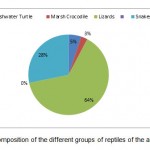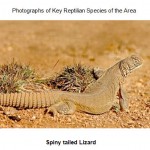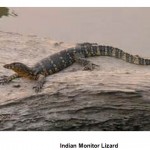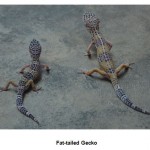Distribution and Current Status of the Reptiles of Khirthar Protected Area Complex (KPAC) and Adjoining Areas in Districts Karachi, Jamshoro and Thatta, Sindh, Pakistan
Syed Ali Ghalib1 * , Muhammad Zaheer Khan1 , Afsheen Zehr1 , Abeda Begum1 , Babar Hussain2 , Abdur Razzaq Khan3 , Saquib Ejaz Hussain4 , M Usman Ali Hashmi1 , Fozia Tabbassum1 , Naseem Samreen1 and Tahira Abdul Lateef1
1
Department of Zoology,
University of Karachi,
Karachi,
75270
Pakistan
2
The World Conservation Union (IUCN),
1 Bath Island Road,
Karachi,
Pakistan
3
Halcrow Pakistan (Pvt) Limited,
Karachi,
Pakistan
4
Environmental Management Consultants (EMC),
Karachi,
Pakistan
DOI: http://dx.doi.org/10.12944/CWE.10.1.13
Copy the following to cite this article:
Zehra A, Ghalib S. A, Khan M. Z, Begum A, Hussain B, Khan A. R, Hussain S. E, Hashmi M. U. A, Tabbassum F, Samreen N, Lateef T. A. Distribution and Current Status of the Reptiles of Khirthar Protected Area Complex (KPAC) and Adjoining Areas in Districts Karachi, Jamshoro and Thatta, Sindh. Curr World Environ 2015;10(1) DOI:http://dx.doi.org/10.12944/CWE.10.1.13
Copy the following to cite this URL:
Zehra A, Ghalib S. A, Khan M. Z, Begum A, Hussain B, Khan A. R, Hussain S. E, Hashmi M. U. A, Tabbassum F, Samreen N, Lateef T. A. Distribution and Current Status of the Reptiles of Khirthar Protected Area Complex (KPAC) and Adjoining Areas in Districts Karachi, Jamshoro and Thatta, Sindh. Curr World Environ 2015;10(1). Available from: http://www.cwejournal.org?p=597/
Download article (pdf)
Citation Manager
Publish History
Select type of program for download
| Endnote EndNote format (Mac & Win) | |
| Reference Manager Ris format (Win only) | |
| Procite Ris format (Win only) | |
| Medlars Format | |
| RefWorks Format RefWorks format (Mac & Win) | |
| BibTex Format BibTex format (Mac & Win) |
Article Publishing History
| Received: | 2014-09-11 |
|---|---|
| Accepted: | 2015-01-12 |
The present studies were undertaken in some important areas for reptiles in Sindh viz. Khirthar Protected Area Complex (KPAC) and in Jhimpir area (Thatta District). The Khirthar Protected Areas Complex (KPAC) stretches over 4,350 km2, encompassing the Protected Areas (PAs) that lie in Kohistan area in the southwest of Sindh and it comprises of Khirthar National Park (KNP), the Mahal Kohistan (MKWS) and Hub Dam Wildlife Sanctuaries (HDWS), and the Surjan, Sumbak, Eri, and Hothiano Game Reserves (SGR).The KNP, MKWS, and HDWS were notified on January 31, 1974. The Park stretches over 3,087 km2, while the MKWS and the HDWS cover 705.7 km2 and 272 km2, respectively. The SGR was established in June 1976 over an area of 285.3 km2. The KPAC is significant for its sizeable indigenous settlements, rugged terrain, valuable flora and mineral resources, and a number of important wildlife species such as the Sindh Ibex, Urial, and Chinkara, Houbara Bustard, Gray Partridge, See-see Partridge and Birds of Prey. Archeologically significant sites include the tombs in Taung, the fort of Rannikot, and the fossils and petrified forests of the Khirthar Range. In addition to these sites, field surveys were also made in some selected potentially important localities in Darawat Dam Area (District Jamshoro) and Jhimpir Wind Corridor area (District Thatta) and data were collected in respect of reptiles of the area, particularly the Indian Spiny-tail Lizard, and the Monitor Lizards. Previous studies made on the reptilian fauna of the area include: Minton (1966), University of Melbourne (2000), Mirza (2002), Khan (2006), Khan et al. (2012, 2012a), Environmental Management Consultants (2012), Begum et al. (2013, 2013a) and Hashmi et al. (2013).
Materials and Methods Study Areas
The main study areas for the present study which form most of the main components of entire Protected Area Complex include Khirthar National Park (Karchat Area and Khar Centre Area), Mahal Kohistan Wildlife Sanctuary, Surjan, Sumbak, Eri, and Huthiano Game Reserves These areas comprised of cliffs, peaks, canyons, stony foothills, rocky slopes; mountain streams/nullahs; stony shrub lands; riparian areas; plains; villages; agricultural areas; tombs and graveyards; and wetlands. Surveys were also undertaken in selected localities in Jhimpir area and in Darawat Dam Area. Inland Jhampir is located north to the Indus Delta on the right bank of River Indus and close to Keenjhar Lake. The area mainly constitutes an environment with undulating stony plain and scattered vegetation. Few patches of seasonal barani agriculture may also be seen which is cultivated during the rainy season. The stony plains are wintering habitat for many migratory birds including Sandgrouses, Houbara Bustard and some raptor species. A number of reptile species are found in the area which include Indian Spiny tailed Lizard, Indian Monitor, Desert Monitor, Indian Cobra, Saw-scaled Viper, Cheekered Keel back, Cliff Racer, Glossy bellied Racer and Pakistan Ribbon Snake. Darawat Dam is located near village Jhangri, 20km west of super Highway at about 135 km NW of Karachi. It is quite close to the Game Reserves areas in KPAC. 08 species of reptiles have been recorded from the area, the important ones being the Monitor Lizards (Begum et al. 2013). The following survey techniques were applied for collection of data regarding the occurrence and distribution of reptiles in the study areas.
Plot Searching
At each site, search was carried out to detect as many reptile species as possible within a circular central zone. This consisted of searching approximately 20 ha for a reasonable time and recording the species observed.
Night Observations
Transect Method was applied to record lizards and snakes with portable spotlight within transects of suitable length.
Turning of Stones and Rocks
Reptiles take shelter or hide themselves under the stones or rocks. In the day time surveys, stones or rotten fallen were turned over to record the presence of reptiles, if any.
Indirect Evidences
Evidences of finger or footprints, fecal pellets, tracks, burrows and tunnels were also collected to record the presence of various species. Information was also collected from the local wildlife staff and from the local communities of the study area.
Results and Discussion
Earlier data about the biodiversity of the area had been collected during the Environmental Study of KPAC in 2000 and 2012. Moreover, some data have also been collected through EIA studies undertaken in the Protected Areas included in the KPAC during the period 2008 – 2013 .Based on both studies, 36 species of reptiles were recorded from KNP (UoM, 2000).While, 38 species were reported from the KPAC during 2012 (EMC, 2012). During the present study, 41 species of reptiles comprising of 3 orders, 14 families and 04 groups have been recorded from the area (Tables 1, 2 and fig.1).
Table 1. Number of species of different groups of Reptiles recorded.
| S. No. | Group | Number of Species |
| 1. | Freshwater Turtles | 02 |
| 2. | Marsh Crocodile | 01 |
| 3. | Lizards | 27 |
| 4. | Snakes | 11 |
 |
Figure 1: Species composition of the differentgroups of reptiles of the area Click here to View figure |
Table 2. Checklist of Reptiles of KPAC and Allied areas.
| S. No. | Order | Family | Scientific Name | Common Name |
| 1 | Chelonia | Emydidae | Geoclemys hamiltonii | Yellow Spotted Mud Turtle |
| 2 | Chelonia | Emydidae | HardellaThurjii | Common River Turtle |
| 3 | Crocodilia | Crocodylidae | Crocodylus palustris | Marsh Crocodile |
| 4 | Squamata | Agamidae | Calotes versicolor | Indian Garden Lizard/ Common Tree Lizard |
| 5 | Squamata | Agamidae | Laudakia lirata | Yellow-headed Spotted Rock Agama |
| 6 | Squamata | Agamidae | Laudakia melanura | Black Rock Agama |
| 7 | Squamata | Agamidae | Laudakia nupta | Rock Agama |
| 8 | Squamata | Agamidae | Trapelus agilis | Brilliant Agama / Common Field Agama |
| 9 | Squamata | Agamidae | Trapelus megalonyx | Afghan Agama/ Ocellate Ground Agama |
| 10 | Squamata | Agamidae | Trapelus rubrigularis | Red- throated Agama |
| 11 | Squamata | Eublepharidae | Eublepharis macularius | Indian Fat-tailed Gecko |
| 12 | Squamata | Gekkonidae | Agamura persica | Persian Spider Gecko |
| 13 | Squamata | Gekkonidae | Cyrtopodion kachhensis | Warty Rock Gecko / Kutch Spotted Ground Gecko |
| 14 | Squamata | Gekkonidae | Cyrtopodion scabrum | Keeled Rock Gecko/ Common Tuberculate Ground Gecko |
| 15 | Squamata | Gekkonidae | Crossobamon orientalis | Sind or Yellow tailed Sand Gecko |
| 16 | Squamata | Gekkonidae | Hemidactylus brookii | Spotted Indian House Gecko / Spotted Barn Gecko |
| 17 | Squamata | Gekkonidae | Hemidactylus flaviviridis | Yellow bellied House Gecko |
| 18 | Squamata | Gekkonidae | Hemidactylus leschenaultia | Tree Bark Gecko |
| 19 | Squamata | Gekkonidae | Hemidactylus persicus | Persian House Gecko |
| 20 | Squamata | Gekkonidae | Hemidactylus triedrus | Blotched House Gecko |
| 21 | Squamata | Gekkonidae | Teratolepis faciata | Flat-tail Gecko |
| 22 | Squamata | Gekkonidae | Tropiocolotes persicus | Persian Banded or Sind Dwarf Gecko |
| 23 | Squamata | Lacertidae | Acanthodactylus cantoris | Indian Fringe-toed Lizard or Bartailed Sand Lizard |
| 24 | Squamata | Lacertidae | Mesalina watsonana | Long tailed Desert Lacerta / Spotted Lacerta |
| 25 | Squamata | Lacertidae | Ophisops jerdoni | Punjab Snake –eyedLizard / Rogose Spectacled Lacerta |
| 26 | Squamata | Scincidae | Eurylepis taeniolatus | Yellow – bellied Mole Skink/ Common Mole Skink |
| 21 | Squamata | Scincidae | Novoeumeces blythianus | Orange tail Skink |
| 27 | Squamata | Scincidae | Ophiomorous tridactylus | Indian Sand Swimmer |
| 28 | Squamata | Uromastycidae | Saara hardwickii | Indian Spiny tailed Lizard |
| 29 | Squamata | Varanidae | Varanus bengalensis | Indian Monitor |
| 30 | Squamata | Varanidae | Varanus griseus | Desert Monitor |
| 31 | Squamata | Typhlopidae | Ramphotyphlops braminus | Brahminy Blind Snake |
| 32 | Squamata | Typhlopidae | Typhlops ductuliformes | Slender Blind Snake |
| 33 | Squamata | Boidae | Eryx johnii | Common Sand Boa |
| 34 | Squamata | Colubridae | Platyceps rhodorachis | Cliff Racer |
| 35 | Squamata | Colubridae | Platyceps ventromaculatus | Glossy bellied Racer/ Plains Racer |
| 36 | Squamata | Colubridae | Psammophis candanura | Indian Sand Snake |
| 37 | Squamata | Colubridae | Psammophis leithii | Sindh Ribbon Snake |
| 38 | Squamata | Colubridae | Spalerosophis diadema | Blotched Diadem Snake/ Royal Snake |
| 39 | Squamata | Elapidae | Bungarus caeruleus | Common Krait |
| 40 | Squamata | Elapidae | Naja naja | Black Cobra |
| 41 | Squamata | Viperidae | Echis carinatus | Saw scaled Viper |
Key Sites
22 sites in the study area have been identified as sites of potential importance for the reptiles (Table 3). Out of these, the most important ones are the Khar Centre, Mahal Kohistan Wildlife Sanctuary, Darawat Dam Area and the sites earmarked for installation of Wind Power Plants in the Jhimpir Wind Corridor (District Thatta).
Table 3. Important Areas for Reptiles.
| S. No. | Important Areas | Co-ordinates |
| 1 | Area near Dargah Fakir Muhammad Ali (Sandy, Grassy Plain),KPAC | 25 43 07.7 N67 50 34.0 E |
| 2 | Area near Goth Rahu Chang, Jhimpir | 25 08 01.0 N67 59 55.1 E |
| 3. | Area near Goth Waryaam Palari, Jhimpir | 25 06 56.9 N67 47 12.6 E |
| 4 | Darawat Dam Area | 25 24 38.0 N67 56 37.4 E |
| 5 | Goran/ Garr, Thano Ahmed Khan(Sandy Area) | 25 24 41.6 N67 39 06.1 E |
| 6 | Gambokh Water Point, KPAC | 25 26 51.0 N67 34 07.0 E |
| 7 | Hub Dam (Crocodile Point) | 25 19 57.7 N67 10 34.4 E |
| 8 | Halalo Pachraan (Sandy, Rocky Plain Area) , KPAC | 25 14 23.0 N67 26 10.7 E |
| 9 | Khar Centre | 25 19 59.3 N67 10 32.6 E |
| 10 | Kallogoth Naddi, Malir District | 25 07 54.9 N67 47 52.6 E |
| 11 | Lailaanwari Boothi, near Rano Jabal, KPAC | 25 42 38.0 N67 42 55.0 E |
| 12 | Mole Shareef (Flat Plain Area) , KPAC | 25 27 42.3 N67 25 54.1 E |
| 13 | Mithrhi Area (Vegetation Area) , KPAC | 25 24 55.8 N67 42155.4 E |
| 14 | Moidan, Plain Area,Khar Center | 25 25 26.5 N67 13 30.8 E |
| 15 | Near Dargah Usman Shah, on road to Dureji (Flat Plain Area)- | 25 22 53.2 N67 12 35.9 E |
| 16 | Indian Spiny-tailed Lizard habitat Jhimpir area Near Haji Lakhano Goth / Shailee Chang Goth (Sandy Plain Area) | 25 09 21.7 N67 57 24.1 E |
| 17 | Near Bachani Sub- Centre , KPAC | 25 32 00.2 N67 50 08.7 E |
| 18 | Near Eri Game Reserve | 25 33 18.9 N67 52 20.5 E |
| 19 | Near Mohd. Siddiq Sehtani Village (Water Point/ Rocky Area), KPAC | 25 55 03.0 N67 39 43.0 E |
| 20 | Sumbak Game Reserve | 25 24 42.0 N67 52 56.4 E |
| 21 | Thano Bula Khan | 25 20 49.5 N67 50 48.0 E |
| 22 | Uth Palaan Area (Nullah, Rocky sides, Sandy Flood Plain), KPAC | 25 11 58.5 N67 30 01.1 E |
Most of the Protected Area provides suitable habitat for the reptiles. Five species of reptiles were found to be quite common in the area. These include: Common Tree Lizard, Sind Sand Gecko, Indian Spiny tailed Lizard, Desert Monitor and Saw- scaled Viper.
Status of Reptiles
As regards the threats to the reptiles in the area, only recently the Indian Fat-tailed Gecko has been found to be nearly wiped out of the area due to its commercial value and its large scale capture for trade. Moreover, there are potential threats to the Monitor Lizards and Indian Spiny-tailed Lizard due to developmental activities in Darawat Dam Area (District Jamshoro) and also in Jhimpir Wind Corridor Area (District Thatta) on account of Wind Power Projects being launched in the area. Marsh Crocodile and the Crowned River Turtle are the Vulnerable Species of the area and these were recorded from Hub Dam Reservoir (District Karachi). Marsh Crocodile and the Monitor Lizards have been declared totally protected species against hunting and shooting etc under the Sind Wildlife Protection Ordinance 1972. Five species of reptiles have been identified as Species of Special Conservation Interest which include Marsh Crocodile, Indian Spiny-tailed Lizard, Indian Monitor, Desert Monitor and Indian Fat-tailed Gecko.
Priority Actions
The following conservation measures have been suggested for saving the reptiles of the area against potential threats:
- Monitoring of the populations of Indian Fat-tailed Gecko, Indian Monitor, Desert Monitor and Indian Spiny tailed Lizard.
- Encouraging and supporting the private sector for captive breeding of monitor Lizards and Indian Fat-tailed Gecko due to their commercial value.
- Safeguarding the key habitats of Indian Spiny-tailed Lizards particularly in Thatta District.
 |
Figure 2: Photographs of Key Reptilian Species of the Area Click here to View figure |
 |
Figure 3: Indian Monitor Lizard Click here to View figure |
 |
Figure 4: Fat-tailed Gecko Click here to View figure |
Acknowledgement
Thanks are due to Mr. Ghulam Sarwar Jamali, Assistant Conservator, Sindh Wildlife Department and his staff particularly m/s Mobin, Azam, Ramzan, Abdul Hafeez and Dad Mohammad for their help in the field surveys in the Mahal Kohistan Wildlife Sanctuary and four Game Reserves. The authors are indebted to Dr. Syed Atiqur Rahman, Mr. Mustafa Matloob, Ms. Tasneem Bhatti and Ms. Fizza Qureshi for their support in the field.
References
- Minton, S.A. 1996. A Contribution to the Herpetology of West Pakistan. Bull. Amer. Mus. Nat. Hist. 134:24-184.
- University of Melbourne. 2000. Environmental Baseline of Khirthar National Park. (Unpublished Report)
- Mirza, Z. B. 2002. A Pocket Guide to Khirthar National Park and its adjoining protected areas. PKP exploration Limited, Islamabad.
- Khan, M.S. 2006. Amphibians and Reptiles of Pakistan. Kriegar Publishing Company, Malabar, Florida. pp. 311.
- Khan, M.Z., Begum, A., Ghalib. S.A., Khan, A.R., Yasmeen, R., Siddqui, T.F.,
- Zehra, A., Abbas, D., Tabassum, F., Siddqui, S.,Jabeen, T. and Hussain, B. 2012. Effects of Environmental Pollution on Aquatic Vertebrate Biodiversity and Inventories of Hub Dam: Ramsar Sites. Canadian Journal of Pure and Applied Science. 6(2): 1913 - 1935.
- Khan, M.Z., Abbas, D., Ghalib. S.A, Siddqui. S., Siddiqui, T. F., Farooq, Yasmeen. R., Yasmeen, G. Abbas D. and Zehra, A. 2012a. Current Status and Distribution of Reptiles of Sindh. Journal of Basic and Applied Sciences.8 (1): 26 – 34.
- Environmental Management Consultants (EMC). 2012. Environmental Baseline of Khirthar Protected Area Complex (KPAC). (Unpublished Report).
- Begum, A., Ghalib, S.A., Zehra, A.,Khan, A. R. and Tabassum, F. 2013. A Qualitative Study of the Wildlife of Darawat Dam, Thatta District, Sindh, Pakistan. International Journal of Advanced Research. 1 (7): 202 – 206. Begum, A., Khan, M. Z., Ghalib, S.A., Khan, A, R., Zehra, A., Hussain, B., Siddiqui,S. and Tabbassum, F. 2013a. Current Status of Mammals and Reptiles at Hub Dam Area, Sindh / Balochistan, Pakistan. Current World Environment Vol. 8(3):395-402.
- Hashmi, M. U. A., Khan, M.Z., Amtiyaz, and Huda, N. 2013. Current Status, and Distribution and Threats of Varanus species (Varanus bengalensis and V. griseus) in Karachi and Thatta of Sindh. Int. J. Fauna and Biological Studies. 1(1): 34 – 38.






